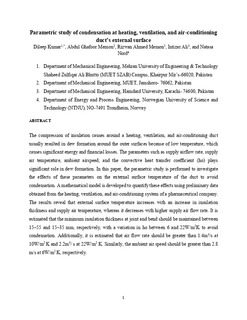| dc.description.abstract | The compression of insulation causes around a heating, ventilation, and air-conditioning duct usually resulted in dew formation around the outer surfaces because of low temperature, which causes significant energy and financial losses. The parameters such as supply air flow rate, supply air temperature, ambient air speed, and the convective heat transfer coefficient (ho) plays significant role in dew formation. In this paper, the parametric study is performed to investigate the effects of these parameters on the external surface temperature of the duct to avoid condensation. A mathematical model is developed to quantify these effects using preliminary data obtained from the heating, ventilation, and air-conditioning system of a pharmaceutical company. The results reveal that external surface temperature increases with an increase in insulation thickness and supply air temperature, whereas it decreases with higher supply air flow rate. It is estimated that the minimum insulation thickness at joint and bend should be maintained between 15–55 and 15–35 mm, respectively, with a variation in ho between 6 and 22 W/m2K to avoid condensation. Additionally, it is estimated that air flow rate should be greater than 1.4 m3/s at 10 W/m2 K and 2.2 m3/s at 22 W/m2 K. Similarly, the ambient air speed should be greater than 2.8 m/s at 6 W/m2 K, respectively.
Practical application: Building services engineers have a paucity of information on the effects of the compression of heating, ventilation, and air-conditioning duct thermal insulation. It can cause condensation that will adversely affect the insulation material, thereby increasing the maintenance cost as well increasing the heat loss from the duct so affecting the conditions of supply air. Proper insulation thickness and operating parameters are important for building owners and operators to control ongoing expenses of buildings. This paper seeks to quantify the effect of insulation compression to improve understanding so that this important area may be properly considered by the building services engineer. | nb_NO |
